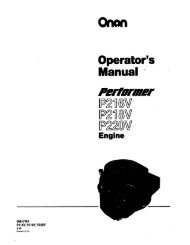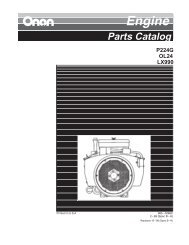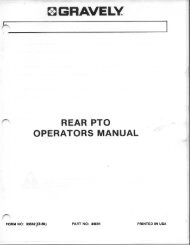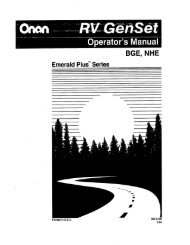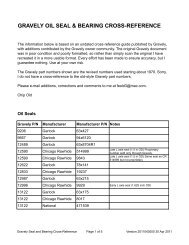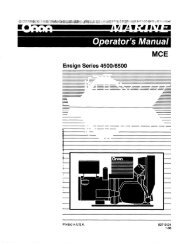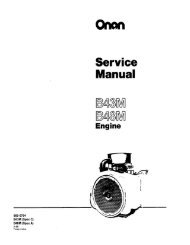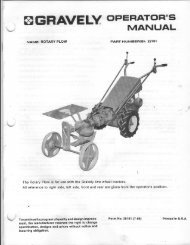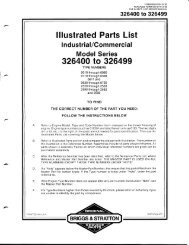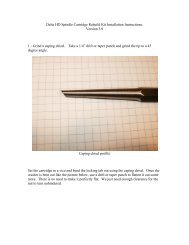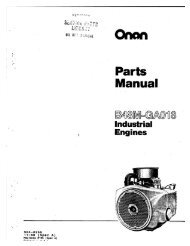272144 Vanguard Twin Cylinder OHV BRIGGS & STRATTON.pdf
272144 Vanguard Twin Cylinder OHV BRIGGS & STRATTON.pdf
272144 Vanguard Twin Cylinder OHV BRIGGS & STRATTON.pdf
Create successful ePaper yourself
Turn your PDF publications into a flip-book with our unique Google optimized e-Paper software.
Output Test<br />
WHEN CHECKING ALTERNATOR COMPONENTS<br />
MAKE TESTS IN THE FOLLOWING SEQUENCE:<br />
Temporarily disconnect stator wire harness from<br />
regulator-rectifier.<br />
1. Insert RED test lead into V receptacle in meter.<br />
2. Insert BLACK test lead into COM receptacle.<br />
3. Rotate selector to V~ (AC VOLTS) position.<br />
4. Attach RED test lead clip (1) to GREEN output<br />
terminal (3), Fig. 24.<br />
Connect stator wire harness to regulator-rectifier.<br />
1. Insert RED test lead into 10A receptacle in<br />
meter.<br />
2. Insert BLACK test lead into COM receptacle.<br />
3. Rotate selector to A== (DC AMPS) position.<br />
4. Attach RED test lead clip (1) to RED DC output<br />
terminal (3) on regulator-rectifier, Fig. 25.<br />
<br />
5. Attach BLACK test lead clip (2) to engine<br />
ground.<br />
6. With the engine running at 3600 RPM, AC output<br />
should be no less than:<br />
• 28 Volts AC – 5 Amp System<br />
• 40 Volts AC – 9 Amp System<br />
7. If NO or LOW output is found, replace the stator.<br />
ÌÌ<br />
<br />
ÌÌ<br />
ÌÌ<br />
Fig. 25<br />
<br />
5. Attach BLACK test lead clip (2) to POSITIVE (+)<br />
battery terminal.<br />
<br />
Fig. 24<br />
Regulator-Rectifier Test<br />
ÌÌ<br />
<br />
<br />
NOTE: The regulator-rectifier will not function<br />
unless it is grounded to engine. Make sure<br />
the regulator-rectifier is securely mounted<br />
to the engine. When testing<br />
regulator-rectifier for amperage output, a<br />
12 volt battery with a minimum charge of 5<br />
volts is required. There will be no output if<br />
battery voltage is below 5 volts.<br />
CAUTION: Connect test leads BEFORE starting<br />
engine. Be sure connections are secure. If a<br />
test lead vibrates loose while engine is<br />
running, the regulator-rectifier may be<br />
damaged.<br />
6. Run the engine at 3600 RPM. The output<br />
should be:<br />
• 3-5 Amps – 5 Amp System<br />
• 3-9 Amps – 9 Amp System<br />
NOTE: The amperage produced depends on<br />
battery voltage. If the battery is below 11<br />
volts, the output reading would be 5 or 9<br />
amps, depending upon the alternator<br />
system being tested. The amperage will be<br />
less at maximum battery voltage.<br />
7. If NO or LOW output is found, be sure that<br />
regulator-rectifier is grounded properly and all<br />
connections are clean and secure. If there is still<br />
NO or LOW output, replace the<br />
regulator-rectifier.<br />
10 & 16 Amp Regulated Alternator<br />
The 10 or 16 amp regulated alternator system<br />
provides AC current through two YELLOW output<br />
leads to the regulator-rectifier. The regulator-rectifier<br />
converts the AC current to DC and regulates current<br />
to the battery. The charging rate varies with engine<br />
RPM and temperature.<br />
The stator and regulator-rectifier are the same for<br />
the 10 and 16 amp systems. The system output is<br />
determined by the flywheel magnet size.<br />
1. Stator Assembly (1) – 10 or 16 amp DC<br />
regulated system, Fig. 26.<br />
41




